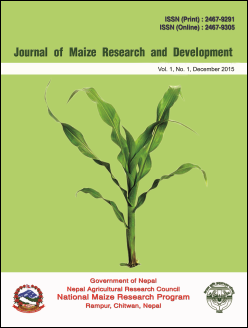A review on threat of gray leaf spot disease of maize in Asia
DOI:
https://doi.org/10.3126/jmrd.v1i1.14245Keywords:
Cercospora, epidemiology, inheritance, resistanceAbstract
Biotic and biotic constraints are yield limiting factors in maize producing regions. Among these gray leaf spot is a yield limiting foliar disease of maize in high land regions of Asia. This review is done from related different national and international journals, thesis, books, research papers etc. The objectives of this review are to become familiar with genetics and inheritance, epidemiology, symptoms and disease management strategies etc. High relative humidity, temperature, minimum tillage and maize monoculture are important factors responsible for disease development. The sibling species of Cercospora zeae-maydis (Tehon and Daniels, 1925) Group I and Group II and Cercospora sorghai var. maydis (Chupp, 1954) are associated with this disease. Pathogens colonize in maize debris. Conidia are the source of inoculums for disease spread. Severe blighting of leaves reduces sugars, stalk lodging and causes premature death of plants resulting in yield losses of up to 100%. Disease management through cultural practices is provisional. The use of fungicides for emergencies is effective however; their prohibitive cost and detrimental effects on the environment are negative consequences. The inheritance of tolerance is quantitative with small additive effects. The introgression of resistant genes among the crosses of resistant germplasm enhances the resistance. The crosses of resistant and susceptible germplasm possess greater stability than the crosses of susceptible and resistant germplasm. The development of gray leaf spot tolerant populations through tolerance breeding principle is an economical and sustainable approach to manage the disease.
Journal of Maize Research and Development (2015) 1(1):71-85




